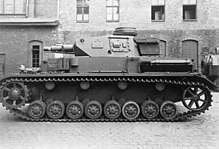7.5 cm KwK 37

The 7.5 cm KwK 37 L/24 (7.5 cm Kampfwagenkanone 37 L/24) was a short-barreled, howitzer-like German 75 mm tank gun used during World War II, primarily as the main armaments of the early Panzer IV tanks. Slightly modified as StuK 37, it was also mounted in early StuG III assault guns.
It was designed as a close-infantry support artillery gun firing a high-explosive shell (hence the relatively short barrel), but was also effective against the early war tanks it faced during the period. Starting from March 1942,[1] new variants of the Panzer IV and StuG III had their main armament upgraded, as a derivation of the 7.5 cm PaK 40 anti-tank gun for a self-moving turreted platform, to the new longer-barreled 7.5 cm KwK 40. When older Panzer IVs were upgunned, their former KwK 37 guns were reused to arm later Panzer III tanks and other infantry support vehicles. In 1943 depleted stocks and continued demand from producing Panzer III Ausf. N required restarting production of a slightly revised version under the designation 7.5 cm K 51 L/24 (7.5 cm Kanone 51 L/24).
Ammunition
KwK 37 used shell 75×243 mm. R [2]
- K.Gr.rot.Pz. - Armour Piercing Capped
- Kt. Kw. K. - Canister
- Nbgr. Kw. K. - Smoke
- Gr.38 Hl - High Explosive Anti-Tank
- Gr.38 Hl/A - High Explosive Anti-Tank
- Gr.38 Hl/B - High Explosive Anti-Tank
- Gr.38 Hl/C - High Explosive Anti-Tank
7.5 cm Sprgr.34 - High Explosive
- Projectile weight: 4.422 kg (9.75 lb)
- Explosive weight: 0.454 kg (1.00 lb) (1900 Kilojoules) [3]
PzGr. 39/43 Armour-piercing
- Projectile weight: 6.80 kg (15.0 lb)
- Muzzle velocity: 385 m/s (1,260 ft/s)
| Range | Penetration | Hit probability (%) |
|---|---|---|
| 100 | 41 | 100 |
| 500 | 39 | 100 |
| 1000 | 35 | 97 |
| 1500 | 33 | 82 |
| 2000 | 30 | n/a |
Penetration comparison
| Ammunition type | Muzzle velocity (m/s) | Penetration (mm) | ||||||||||
|---|---|---|---|---|---|---|---|---|---|---|---|---|
| 100 m | 250 m | 500 m | 750 m | 1000 m | 1250 m | 1500 m | 2000 m | 2500 m | 3000 m | |||
| Pzgr. 39/1 (APCBC) | 385 m/s (1,260 ft/s) | 54 | 53 | 50 | 48 | 46 | 44 | 42 | 38 | 35 | 32 | |
| Pzgr. 39/2 (APCBC) | 385 m/s (1,260 ft/s) | 60 | 58 | 55 | 52 | 50 | 47 | 44 | 38 | 33 | 27 | |
| Gr.38 Hl (HEAT) |
450 m/s (1,500 ft/s) | 52 | 52 | 52 | 52 | 52 | 52 | 52 | 52 | 52 | 52 | |
| Gr.38 Hl/A (HEAT) | 450 m/s (1,500 ft/s) | 81 | 81 | 81 | 81 | 81 | 81 | 81 | 81 | 81 | 81 | |
| Gr.38 Hl/B (HEAT) | 450 m/s (1,500 ft/s) | 87 | 87 | 87 | 87 | 87 | 87 | 87 | 87 | 87 | 87 | |
| Gr.38 Hl/C (HEAT) | 450 m/s (1,500 ft/s) | 115 | 115 | 115 | 115 | 115 | 115 | 115 | 115 | 115 | 115 | |
Vehicles mounted on
- Neubaufahrzeug
- Panzer III Ausf. N
- Panzer IV Ausf. A, C, D, E, and F1
- StuG III Ausf. A, B, C, D, and E
- SdKfz.233 Schwerer Panzerspähwagen
- SdKfz.234/3 Schwerer Panzerspähwagen "Stummel"
- SdKfz.250/8 Schützenpanzerwagen (7.5 cm KwK37)
- SdKfz.251/9 Schützenpanzerwagen (7.5 cm KwK37)
See also
- Howitzer Motor Carriage M8, armed with 75mm American M2 or M3 howitzer
Notes
- ↑ Finkel "On Flexibility", p. 143.
- ↑ http://www.quarryhs.co.uk/ammotable8.html
- ↑ German Explosive Ordnance (Projectiles and Projectile Fuzes) - Department of the Army Technical Manual TM-9-1985-3. 1953. p. 417.
- ↑ http://www.panzerworld.com/7-5-cm-kw-k-l-24
- ↑ Bird, Lorrin Rexford; Livingston, Robert D. (2001). WWII Ballistics: Armor and Gunnery. Overmatch Press. p. 61.
External links
| Wikimedia Commons has media related to 7.5 cm KwK 37. |